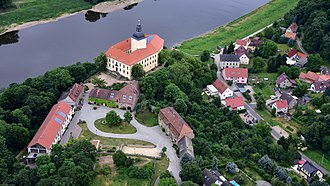Hirschstein Castle
The Hirschstein Castle (also Neuhirschstein ) is a castle that emerged from a medieval castle in the municipality of Hirschstein in the district of Meißen . It rises imposingly on a 25 meter high rock on the left bank of the Elbe opposite Neuseußlitz .
history
A castle complex was mentioned at this location as early as 1205, but it probably existed as early as the 10th century. From 1420 onwards, von Birkigt and from 1451 onwards, von Haugwitz were named as gentlemen on Hirschstein. It was not until 1497 that the term castle was used in connection with the complex. The name Nau Hirstein is mentioned in a document from 1551 . The owners of the palace changed several times, including nobles from the Dresden court. Around 1590 the castle was acquired by Hartmann Pistoris from the ennobled family of scholars Pistoris and remained in the family until and including Johann Ernst Pistoris' lifetime . The facility was expanded in the 17th century. A settlement was built around the castle, which took the name Hirschstein. A feudal estate developed, for which the residents of Althirschstein , Bahra , Böhla , Blattersleben , Fichtenberg, Kobeln , Leckwitz , Weißig and Windorf had to do labor.
In 1892 the hussar mountaineer Max Crusius from Großenhain bought the castle and had it rebuilt and modernized in 1893/94. After his death in 1907, his widow lived in the castle. During the Second World War, art treasures from the Dresden art collections were stored here. On October 7, 1943, the SS confiscated the castle. When the Allies landed in France on June 6, 1944, the Belgian King Leopold III. arrested with his family on Himmler's orders and housed as a state prisoner under strict SS surveillance until March 6, 1945 at Hirschstein Castle. After the war, was in the plant hospital of the Red Army . The castle was then used as a children's rest home from 1949 to 1955, and then from 1957 as a children's sanatorium and rehabilitation clinic. Most recently it served as a rehabilitation clinic for children and adolescents with psychosomatic disorders from 2000 to 2006. It has been owned by the Meißen district since 2009.
An old escape route from the 15th century is said to exist from the castle, which led under the Elbe to the Zottewitz Castle, which no longer exists today . Most of it has been filled up.
literature
- Hans and Doris Maresch: Saxony's palaces and castles , Husum Druck- und Verlagsgesellschaft mbH u. Co. KG, Husum 2004, ISBN 3-89876-159-2
- Siegfried H. Obst: Hirschstein Castle. Lommatzsch 2014, ISBN 978-3-00-047099-8
- GA Poenicke: Hirschstein . In: Album of the manors and castles in the kingdom of Saxony. II. Section. Meissner circle . Sturm and Koppe, Leipzig 1856, p. 29 ( online ).
- Helmuth Gröger: Hirschstein Castle . In: Burgen und Schlösser in Sachsen , Heimatwerk Sachsen, 1940, p. 111
Web links
Individual evidence
- ↑ Belgian royal family as state prisoners at Hirschstein Castle , website of the Hirschstein community, accessed on April 4, 2011
Coordinates: 51 ° 15 ′ 6.6 ″ N , 13 ° 24 ′ 1 ″ E






